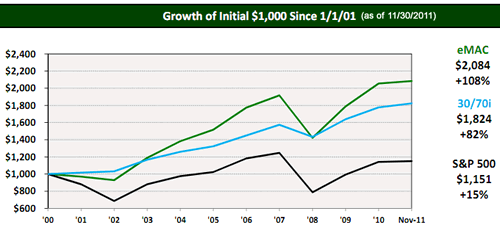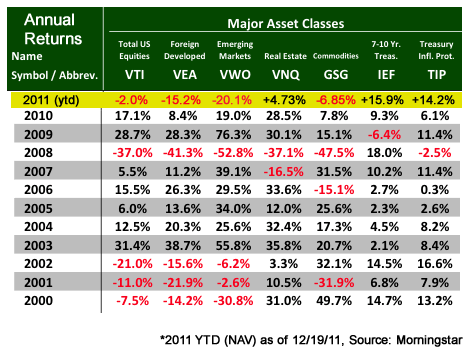It’s time for a end-of-year checkup on the ole’ portfolio, as I’m afraid that I’ll forget about it between Christmas and New Year’s. There isn’t much change to my investment portfolio itself, the target asset allocation is the same, and the specific fund holdings are pretty much the same. I’m closer to 70% stocks and 30% bonds now. With only about 7 trading days left, I wanted to see how the various asset classes that I own performed in 2011.
My portfolio is similar to the David Swensen model portfolio, which uses low-cost index funds to gain exposure to specific asset classes. Here is an implementation of the portfolio using actual ETFs in a recommended 70% stocks / 30% bonds breakdown.
30% Domestic US Equity (VTI)
15% Foreign Developed Equity (VEA)
10% Emerging Markets (VWO)
15% Real Estate (VNQ)
15% U.S. Treasury Bonds (IEF)
15% Inflation-Protected Securities (TIP)
The chart below shows the growth of $1,000 invested this way (eMAC) at the start of 2001 until the end of November 2011, as compiled by the financial advisory group ETF Portfolio Management for benchmark purposes.

I have also taken the liberty of updating their annual returns table to including 2011 year-to-date total returns (see highlighted) using Morningstar data as of 12/19/2011.

The weighted year-to-date return of the overall model portfolio is 0.35%, essentially zero for 2011. But from the table, you see that each individual asset class may have moved a lot. European and Emerging Market stocks performed quite poorly (in case you don’t read the news), the S&P 500 looks like it will more or less go nowhere for the year, REITs (Real Estate) did okay, and Treasury bonds did very, very well considering this low-yield environment. Inflation-Protected bonds (TIPS) were the superstar in my portfolio, they saved my bacon.
Another year, another reminder that predicting short-term market movements is way beyond me. 🙂 I continue to be happy with owning various asset classes with long-term expected positive returns, but which tend not to move in sync and thus smooth out the ride.
Next year, I intend to learn more about an income-oriented portfolio as that may potentially work better – at least psychologically – for the early-retirement set. My secret crush, the Vanguard Wellesley Income Fund (VWINX) was up 7.91% in 2011 YTD. It’s a income-oriented actively-managed fund with about 35% in dividend stocks and 65% in corporate bonds – but with a tiny expense ratio of only 0.28% for investor shares, 0.21% for admiral shares.
 The Best Credit Card Bonus Offers – 2025
The Best Credit Card Bonus Offers – 2025 Big List of Free Stocks from Brokerage Apps
Big List of Free Stocks from Brokerage Apps Best Interest Rates on Cash - 2025
Best Interest Rates on Cash - 2025 Free Credit Scores x 3 + Free Credit Monitoring
Free Credit Scores x 3 + Free Credit Monitoring Best No Fee 0% APR Balance Transfer Offers
Best No Fee 0% APR Balance Transfer Offers Little-Known Cellular Data Plans That Can Save Big Money
Little-Known Cellular Data Plans That Can Save Big Money How To Haggle Your Cable or Direct TV Bill
How To Haggle Your Cable or Direct TV Bill Big List of Free Consumer Data Reports (Credit, Rent, Work)
Big List of Free Consumer Data Reports (Credit, Rent, Work)
Thanks for the update. I also follow this allocation in my traditional IRA. It’s been a good “all weather” portfolio. The weighted return of .35% for this model portfolio is what you’d receive if you bought the portfolio at the beginning of the year and didn’t add capital or rebalance. I wonder if you could share your actual performance including rebalancing and/or contributions if you made them. I’d think it would be a bit higher especially in such a volatile year.
Where’s the asterix? Past performance does not predict future returns. In general, any fund outperforming the S&P will meet the S&Ps performance in the long run. I am concerned that your portfolio merely reflects the relatively high proportion of bonds for your age class.
Jon,
If you end up switching to VWINX, are you planning on moving your entire portfolio to that fund or maybe just a portion or somehow incorporate it as part of the rest of your asset allocation? Thanks.
Do you reinvest the dividends in VWINX…? Is this in your taxable or non taxable
@Andy – I know, but calculating a personal rate of return across all my accounts is a lot of work. 🙂 We’ll see after I get all my account statements for 2011.
@jetest – It’s not really about outperforming the S&P 500, it’s about having less swings too. I agree, if they S&P 500 was on a hot streak, my performance would have probably been less. But hopefully I’d be happy with it anyway. I don’t think anyone should have 100% S&P 500, but that’s how many media articles are written.
@Eric – Definitely only a portion. The bond part of VWINX is mostly corporate bonds, of which I have no exposure to otherwise. The stocks part is mostly bigger high-dividend companies, which I am hoping will be shown to have good income stability as an asset class. As someone living off their portfolio, I think income stability trumps price stability.
@JR – I would reinvest dividends if I didn’t spend it, and I would hold as much as possible in non-taxable.
Thanks for the reply!
Does the eMAC graph above include re-balancing annually?
My returns for the last four years have ranged from 4.1% – 4.34% on a base substantially larger then yours. I’m almost 100% fixed income with holdings in four different countries and five currencies and for the most part, the minimum amount of risk possible.
For me, your results reinforce my belief that buying individual bonds yourself and having a bit of luck with exchange rates is a superior strategy to relying on Vanguard or anybody else for your future retirement and cash flow.
Vanguard Wellesley Income Fund vs. Vanguard Equity Income Fund. Any preference?
@John – Yes, annual rebalance but no transaction costs. (Free ETFs trades on the Vanguard ETFs at Vanguard, free trades on TIP and IEF at TD Ameritrade)
@David – Best of luck in your future investment endeavors, you gotta do what you feel is best for you.
@bruce – Equity Income is all stocks, and half managed by Wellington and half managed by Vanguard Quantitative. Seems like reasonable low-cost option if you want some managed dividend stocks. Also check out Dividend Growth fund. I still prefer Wellesley or Wellington Fund because I like the bond aspect for overall income stability.
Why not just simplify to a Total Stock Market/ Total International Stock Market/Total Bond Market portfolio with a higher allocation to the bonds?
Wellesley just doesn’t seem very diversified. If I wanted to overweight to Dividend Stocks and the Corporate Bonds, I’d consider a mix between VHDYX or VVIAX and then some combination of VFSTX, VFICX, and VWESX .
Wellesley is of course simpler though…
Is this rebalanced automatically?
Just curious – do you hold your Vanguard funds through Vanguard or TD Ameritrade? I’m leaving the world of actively managed funds and going with a Vanguard portfolio and wondering if there’s an advantage to either. It looks like TD has all the funds I’m looking at, but I’m tempted to go with Vanguard so I’ll have other options if I want them.
Thanks.
I hold my Vanguard funds directly at Vanguard and I’ve been happy with them, but TD Ameritrade does have a lot of iShares and other popular ETFs that some people may want to invest in that are also commission-free.
Thanks. I talked to both brokerages today and Vanguard doesn’t reimburse any transfer fees, so I think I’m going with TD Ameritrade – I like the idea of being able to trade the other, non-Vanguard, commission-free ETF’s too. Plus TD Ameritrade has some transfer bonuses for existing accounts (in addition to refunding transfer fees) – $100 for a retirement account under $100k and $600 for a $250k or more transfer into a taxable account, $300 for between $100k and $250k.
In my experience, the major brokerages always have promotions like this if you call and ask. I’ve spent the last 8 years transferring buy-and-hold assets between TD Ameritrade, E*TRADE and Fidelity for money, assorted gifts and miles. FYI, they usually require that you keep the new assets in your account for 6 or 9 months.
I checked and Vanguard doesn’t charge a fee for outgoing transfers (at least per a fee schedule I found on the internet), in case you want to play that game 🙂